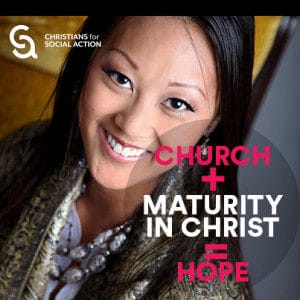
I was fortunate to earn my art degree at a faith-based college that was serious about both art and faith. I vividly remember my first art course in college; we were all so eager and nervous about creating and showing our work. During one of our first critiques, one of the girls in my class was brought to tears as one of the other students called her work “kitsch”—trite or clichéd. It wasn’t that her work was particularly bad—none of us made what could be called good art during that course. Rather it was that her work, which happened to portray a cross, was neither creative nor thought-provoking.
Our professors wanted us to explore what it means to be an artist as well as an artist of faith. Our critiques, like the one described above, were meant to stretch us and help us grow in our skill and thought processes. During the course of my college career, we were constantly asked to define and explore what art is, what its function is, and what makes good art. Although I am no longer a student, I still ask these same questions and explore what it means when we label something “Christian art.”
…we were constantly asked to define and explore what art is, what its function is, and what makes good art. I still ask these same questions and explore what it means when we label something “Christian art.”
Many mainstream and evangelical churches shy away from visual art. This is reflected in our worship spaces, what we sell in our bookstores, and our institutions of higher learning, few of which offer majors in studio art. It is a rare gem of a church that commissions art. When we do see what is called “Christian art,” it is often, as much of the work of my freshman art class, trite. Contemporary Christian culture tends to favor images of cozy, illuminated cottages set in the countryside; happy portrayals of Christ playing soccer with children, and photographs of nature overlaid with biblical verses. The most popular images of Christ show a smiling, pleasant man of European descent. Essentially, the art of our popular Christian culture is what we perceive as good, clean, and safe.
Betty Spackman in A Profound Weakness writes:
“The sentimental in art, including religious art, usually begins as sincerity. So why does it end up coming across as so insincere, cheap, and shallow? One reason, I think, is laziness. We don’t invest enough time and effort to produce work that speaks and feels and looks strong—work that doesn’t rely on clichés but honestly, skillfully speaks ‘the truth with love’ (Eph. 4.15). Clichés are basically these ‘lazy’ forms of art. They are ready-made, copycat forms of expression that require little or no personal soul-searching or intellectual discipline…I doubt that it will ever be possible to be totally ‘original,’ but if we are content merely to copy what we’ve seen or heard we will find ourselves locked into a never-ending cycle of clichés. Unfortunately, a great deal of art that has been produced by Christians does just that.”
The history of Western art is saturated with religious art, Christian art in particular, but today the church has distanced itself from the art world. We have moved past the austerity of the iconoclasts who deemed any created image as idolatry, but perhaps we are still recovering from the Reformation itself. We were, after all, born of a reactionary movement that wanted very much to distance itself from the Roman Catholic Church, which had been—it is worth noting—the largest patron of art for centuries in Europe. Not only did the new Protestant church desire to be distinct from Rome in its structure and creeds, but it also lacked the wealth to commission large works of art. In many Protestant nations, such as Flanders and Holland, art was commissioned by the emerging middle class rather than the church. Artists shifted away from traditional religious themes in order to please their new patrons, and consequently, Europe saw the emergence of portraiture, landscapes, and still life, many of which only fleetingly retained religious symbolism.
Artists have been labeled by generations of religious folks as provocative and controversial at best, dangerous at worst.
In a way, the Reformation led to more secular art. Ironically, over the last few decades, the Protestant church developed a nervous if not distrustful view of the art world it helped to create. Artists have been labeled by generations of religious folks as provocative and controversial at best, dangerous at worst. Feeling threatened by the art world, the church consequently gravitates toward the safe, sterile, and saccharine images mentioned above. But if art reflects the culture that produces it, then what we call “Christian art” is a reflection of our Christian culture. This does not paint a very healthy picture of the contemporary church and is alarming to the extent that it is accurate. God, after all, calls his bride to be neither sterile nor complacent. God calls us to love and truth, not sweetness and inoffensiveness.
The Bible doesn’t talk much about what we in our contemporary culture call art; the weavers, painters, masons, and smiths of Bible times were viewed as tradesmen, not artists. The closest thing that we have to a biblical view of an art of faith is found in the Psalms, the Song of Solomon, and Lamentations. These writings are an artistic record of humanity’s response to God, each other, and our shared human experience. They contain some of the most beautiful and disturbing poems ever penned: songs of praise, faith, love, loss, rage, shame, despair, and even hatred. These three books are not tame or pleasant; rather they are provocative, stormy, exultant–in short, true to the wide range of human emotion and experience. Christian art should reflect this same honesty and complexity, even at the risk of controversy.
Maybe it’s time that the church, like my professors, asked a little more from its artists—and from itself.
Tegan Brozyna is an artist and freelance writer.


